Integrating Virtual Reality and Building Information Modeling for Improving Highway Tunnel Emergency Response Training
Abstract
1. Introduction
2. Literature Review
3. Methods
- Process BIM asset
- (1)
- Configuration of BIM asset in Revit, group family type objects and configure unique ID for each mesh object.
- (2)
- Selecting a view with all the elements that need to be exported.
- (3)
- Clear non-BIM entities such as camera, light source, and section box.
- (4)
- Export elements into FBX format that contains mesh data.
- (5)
- Export elements into JSON format that contains material information and building information.
- (6)
- Export mesh and data link into XML format so the mesh object and building information can be mapped.
- (7)
- Export plans (sites floor plane) into 1:1 vector scale using metric system for reference.
- Prepare BIM data
- (1)
- Load FBX mesh data into Blender.
- (2)
- Re-configure the coordinate system by setup the default world anchor.
- (3)
- Group mesh elements into a spatial hierarchy.
- (4)
- Convert non-Revit documents information into JSON or XML.
- Optimize mesh for VR
- (1)
- Reduce triangle by re-meshing object, especially the cylinder.
- (2)
- Remove double vertex.
- (3)
- Filter and remove annotation mesh objects such as 3D texts and indications.
- (4)
- Relocation double plane to avoid z-index flight.
- (5)
- Calculated inside and outside normal.
- (6)
- Draw double side UV for non-solidified object such as plane and material layers.
- (7)
- Create level of detail for complex objects.
- (8)
- Create/convert to PBR materials for outer layer of the object based on BIM material information.
- (9)
- Unwrap the UV for all the elements for texturing.
- (10)
- Export the model and material into OBJ format.
- Simulate and render
- (1)
- Import OBJ into Unity.
- (2)
- Revaluate the UV layer for lights information.
- (3)
- Set up globes illumination information such as directional lights and skybox.
- (4)
- Set up light reflection probes lone the path of the road in the mesh data.
- (5)
- Before rendering the scene, add extra environments details such as plants if needed.
- (6)
- Bake the lighting of the scene to complete the environment simulation.
- VR interaction
- (1)
- In Unity, add VR support for a target device, in this project, the Oculus Rift.
- (2)
- Add walkable area by adding floor colliders base on the BIM, filter the road surface and add the mesh colliders into the element.
- (3)
- Create internal movement interaction for FPP, a free roam VR experience requires a larger space for the user to walk around, and set up a boundary box to map the physical space to alert the user of approaching the edge of the space.
- (4)
- Create an internal movement of FPS using the teleporting method for a stationary VR experience.
- (5)
- Create object interactions based on the training procedures.
- (6)
- Interaction with tools (build based on the Safety Equipment documents) to use in the scene via gestures (pickup, holding, pointing, and releasing):
- (a)
- Edit sound effects to give feedback on the status while interacting with objects.
- (b)
- Program controller vibration (intensity and frequency) to simulate the feedback of power tools used in the training process.
- (c)
- Created VFX to simulate the result of using the tool on different materials.
- (7)
- Create an immersive menu for document base information display by simulating the clipboard in VR (turning pages).
- Training scenery in VR
- (1)
- Create a scenery storyline based on training documents and safety instructions.
- (2)
- Extract objectives of the training process and divide them into sections.
- (3)
- Build sceneries script and event system in Unity for each section.
- (4)
- Generate procedure training sceneries by connecting sections and their objectives.
- Build training experience in VR
- (1)
- Generate emergency response planning procedures with instruction, each section will provide the user with a clear objective, visual and sound instructions, and path guidance. In this training mode, the user can follow the instruction to complete the emergency planning procedures.
- (2)
- Generate emergency response planning procedures without instruction. Each section will provide the user with only the status update of the event, the user can complete tasks with its knowledge to achieve the objectives. The event is timed so the user can review the result of each section.
4. BIM + VR Training Platform
4.1. Training System 1: For the Operator in the Central Control Room
- Illegal stop in the tunnel
- Car crash in the tunnel
- Heavy fire occurs in the tunnels
4.2. Training System 2: For Emergency Response Group
4.3. Training System 3: For Dangerous Goods Truck Driver
4.4. Training System 4: For Coach Passengers
5. Evaluation
6. Discussion
7. Conclusions
Author Contributions
Funding
Conflicts of Interest
References
- Li, Z.; Li, Y.; Ge, Y.; Wang, Y. Fire Simulation and Optimal Evacuation Based on BIM Technology. In Proceedings of the International Conference on Broadband Communications, Networks and Systems, Virtual Event, 28–29 October 2021; Springer: Cham, Switzerland, 2021. [Google Scholar]
- Huang, S.; Huang, M.; Lyu, Y. Seismic performance analysis of a wind turbine with a monopile foundation affected by sea ice based on a simple numerical method. Eng. Appl. Comput. Fluid Mech. 2021, 15, 1113–1133. [Google Scholar] [CrossRef]
- Ministry of Transport of the People’s Republic of China. Statistical Bulletin on the Development of the Transportation Industry in 2020. Financ. Account. Commun. 2021, 6, 92–97. [Google Scholar]
- Huang, H.; Huang, M.; Zhang, W.; Pospisil, S.; Wu, T. Experimental investigation on rehabilitation of corroded RC columns with BSP and HPFL under combined loadings. J. Struct. Eng. 2020, 146, 04020157. [Google Scholar] [CrossRef]
- Guo, Y.; Yang, Y.; Kong, Z.; He, J. Development of Similar Materials for Liquid-Solid Coupling and Its Application in Water Outburst and Mud Outburst Model Test of Deep Tunnel. Geofluids 2022, 2022, 8784398. [Google Scholar] [CrossRef]
- Sun, J.; Wang, J.; Zhu, Z.; He, R.; Peng, C.; Zhang, C.; Huang, J.; Wang, Y.; Wang, X. Mechanical Performance Prediction for Sustainable High-Strength Concrete Using Bio-Inspired Neural Network. Buildings 2022, 12, 65. [Google Scholar] [CrossRef]
- Buttussi, F.; Chittaro, L. Effects of different types of virtual reality display on presence and learning in a safety training scenario. IEEE Trans. Vis. Comput. Graph. 2017, 24, 1063–1076. [Google Scholar] [CrossRef]
- Gwynne, S.; Kuligowski, E.D.; Boyce, K.E.; Nilsson, D.; Robbins, A.; Lovreglio, R.; Thomas, J.; Roy-Poirier, A. Enhancing egress drills: Preparation and assessment of evacuee performance. Fire Mater. 2019, 43, 613–631. [Google Scholar] [CrossRef]
- Getuli, V.; Capone, P.; Bruttini, A.; Isaac, S. BIM-based immersive Virtual Reality for construction workspace planning: A safety-oriented approach. Autom. Constr. 2020, 114, 103160. [Google Scholar] [CrossRef]
- Kordestani, H.; Zhang, C.; Masri, S.F.; Shadabfar, M. An empirical time-domain trend line-based bridge signal decomposing algorithm using Savitzky–Golay filter. Struct. Control. Health Monit. 2021, 28, e2750. [Google Scholar] [CrossRef]
- Sun, J.; Ma, Y.; Li, J.; Zhang, J.; Ren, Z.; Wang, X. Machine learning-aided design and prediction of cementitious composites containing graphite and slag powder. J. Build. Eng. 2021, 43, 102544. [Google Scholar] [CrossRef]
- Shi, Y.; Du, J.; Lavy, S.; Zhao, D. A multiuser shared virtual environment for facility management. Procedia Eng. 2016, 145, 120–127. [Google Scholar] [CrossRef]
- Carreira, P.; Castelo, T.; Gomes, C.C.; Ferreira, A.; Ribeiro, C.; Costa, A.A. Virtual reality as integration environments for facilities management: Application and users perception. Eng. Constr. Archit. Manag. 2018, 25, 90–112. [Google Scholar] [CrossRef]
- Zhu, Z.; Wu, Y.; Han, J. A prediction method of coal burst based on analytic hierarchy process and fuzzy comprehensive evaluation. Front. Earth Sci. 2022, 9, 1424. [Google Scholar] [CrossRef]
- Li, Z.; Chen, L.; Nie, L.; Yang, S.X. A novel learning model of driver fatigue features representation for steering wheel angle. IEEE Trans. Veh. Technol. 2021, 71, 269–281. [Google Scholar] [CrossRef]
- Azhar, S. Role of visualization technologies in safety planning and management at construction jobsites. Procedia Eng. 2017, 171, 215–226. [Google Scholar] [CrossRef]
- Froehlich, M.A.; Azhar, S. Investigating virtual reality headset applications in construction. In Proceedings of the 52nd Associated Schools of Construction Annual International Conference, Provo, UT, USA, 13–16 April 2016. [Google Scholar]
- Feng, Z.; VGonzález, A.; Amor, R.; Lovreglio, R.; Cabrera-Guerrero, G. Immersive virtual reality serious games for evacuation training and research: A systematic literature review. Comput. Educ. 2018, 127, 252–266. [Google Scholar] [CrossRef]
- Porzycki, J.; Schmidt-Polończyk, N.; Wąs, J. Pedestrian behavior during evacuation from road tunnel in smoke condition—Empirical results. PLoS ONE 2018, 13, e0201732. [Google Scholar] [CrossRef]
- Cao, S.; Liu, X.; Chraibi, M.; Zhang, P.; Song, W. Characteristics of pedestrian’s evacuation in a room under invisible conditions. Int. J. Disaster Risk Reduct. 2019, 41, 101295. [Google Scholar] [CrossRef]
- Sidani, A.; Dinis, F.M.; Sanhudo, L.; Duarte, J.; Baptista, J.S.; Martins, J.P.; Soeiro, A. Recent tools and techniques of BIM-based virtual reality: A systematic review. Arch. Comput. Methods Eng. 2021, 28, 449–462. [Google Scholar] [CrossRef]
- Mallam, S.C.; Nazir, S. Effectiveness of VR head mounted displays in professional training: A systematic review. Technol. Knowl. Learn. 2021, 26, 999–1041. [Google Scholar]
- Shi, L.; Xiao, X.; Wang, X.; Liang, H.; Wang, D. Mesostructural characteristics and evaluation of asphalt mixture contact chain complex networks. Constr. Build. Mater. 2022, 340, 127753. [Google Scholar] [CrossRef]
- Sun, J.; Tang, Y.; Wang, J.; Wang, X.; Wang, J.; Yu, Z.; Cheng, Q.; Wang, Y. A Multi-objective Optimisation Approach for Activity Excitation of Waste Glass Mortar. J. Mater. Res. Technol. 2022, 17, 2280–2304. [Google Scholar] [CrossRef]
- Boton, C.; Rivest, L.; Ghnaya, O.; Chouchen, M. What is at the Root of Construction 4.0: A systematic review of the recent research effort. Arch. Comput. Methods Eng. 2021, 28, 2331–2350. [Google Scholar] [CrossRef]
- Zhou, W.; Qin, H.; Qiu, J.; Fan, H.; Lai, J.; Wang, K.; Wang, L. Building information modelling review with potential applications in tunnel engineering of China. R. Soc. Open Sci. 2017, 4, 170174. [Google Scholar] [CrossRef] [PubMed]
- Tse, T.-C.K.; Wong, K.-D.A.; Wong, K.-W.F. The utilisation of building information models in nD modelling: A study of data interfacing and adoption barriers. J. Inf. Technol. Constr. 2005, 10, 85–110. [Google Scholar]
- Xu, L.; Liu, X.; Tong, D.; Liu, Z.; Yin, L.; Zheng, W. Forecasting Urban Land Use Change Based on Cellular Automata and the PLUS Model. Land 2022, 11, 652. [Google Scholar] [CrossRef]
- Huang, S.; Liu, C. A computational framework for fluid–structure interaction with applications on stability evaluation of breakwater under combined tsunami–earthquake activity. Comput.-Aided Civ. Infrastruct. Eng. 2022. [Google Scholar] [CrossRef]
- Jung, Y.; Joo, M. Building information modelling (BIM) framework for practical implementation. Autom. Constr. 2011, 20, 126–133. [Google Scholar] [CrossRef]
- Wang, S.; Guo, H.; Zhang, S.; Barton, D.; Brooks, P. Analysis and prediction of double-carriage train wheel wear based on SIMPACK and neural networks. Adv. Mech. Eng. 2022, 14, 16878132221078491. [Google Scholar] [CrossRef]
- van Treeck, C.; Rank, E. Dimensional reduction of 3D building models using graph theory and its application in building energy simulation. Eng. Comput. 2007, 23, 109–122. [Google Scholar] [CrossRef]
- Schlueter, A.; Thesseling, F. Building information model based energy/exergy performance assessment in early design stages. Autom. Constr. 2009, 18, 153–163. [Google Scholar] [CrossRef]
- Cheng, M.-Y.; Chiu, K.-C.; Hsieh, Y.-M.; Yang, I.-T.; Chou, J.-S.; Wu, Y.-W. BIM integrated smart monitoring technique for building fire prevention and disaster relief. Autom. Constr. 2017, 84, 14–30. [Google Scholar] [CrossRef]
- Liu, C.; Wu, D.; Li, Y.; Du, Y. Large-scale pavement roughness measurements with vehicle crowdsourced data using semi-supervised learning. Transp. Res. Part C Emerg. Technol. 2021, 125, 103048. [Google Scholar] [CrossRef]
- Ban, Y.; Liu, M.; Wu, P.; Yang, B.; Liu, S.; Yin, L.; Zheng, W. Depth Estimation Method for Monocular Camera Defocus Images in Microscopic Scenes. Electronics 2022, 11, 2012. [Google Scholar] [CrossRef]
- Han, Y.; Wang, B.; Guan, T.; Tian, D.; Yang, G.; Wei, W.; Tang, H.; Chuah, J.H. Research on Road Environmental Sense Method of Intelligent Vehicle Based on Tracking Check. IEEE Trans. Intell. Transp. Syst. 2022, 1–15. [Google Scholar] [CrossRef]
- Chen, H.; Hou, L.; Zhang, G.K.; Moon, S. Development of BIM, IoT and AR/VR technologies for fire safety and upskilling. Autom. Constr. 2021, 125, 103631. [Google Scholar] [CrossRef]
- Sun, R.; Wang, J.; Cheng, Q.; Mao, Y.; Ochieng, W.Y. A new IMU-aided multiple GNSS fault detection and exclusion algorithm for integrated navigation in urban environments. GPS Solut. 2021, 25, 147. [Google Scholar] [CrossRef]
- Meng, F.; Wang, D.; Yang, P.; Xie, G. Application of sum of squares method in nonlinear H∞ control for satellite attitude maneuvers. Complexity 2019, 2019, 5124108. [Google Scholar] [CrossRef]
- Rüppel, U.; Schatz, K. Designing a BIM-based serious game for fire safety evacuation simulations. Adv. Eng. Inform. 2011, 25, 600–611. [Google Scholar] [CrossRef]
- Luo, G.; Zhang, H.; Yuan, Q.; Li, J.; Wang, F.-Y. ESTNet: Embedded Spatial-Temporal Network for Modeling Traffic Flow Dynamics. IEEE Trans. Intell. Transp. Syst. 2022, 1–12. [Google Scholar] [CrossRef]
- Li, Y.; Che, P.; Liu, C.; Wu, D.; Du, Y. Cross-scene pavement distress detection by a novel transfer learning framework. Comput.-Aided Civ. Infrastruct. Eng. 2021, 36, 1398–1415. [Google Scholar] [CrossRef]
- Sun, R.; Zhang, Z.; Cheng, Q.; Ochieng, W.Y. Pseudorange error prediction for adaptive tightly coupled GNSS/IMU navigation in urban areas. GPS Solut. 2022, 26, 28. [Google Scholar] [CrossRef]
- Liu, J.; Chen, Y.; Wang, X. Factors driving waste sorting in construction projects in China. J. Clean. Prod. 2022, 336, 130397. [Google Scholar] [CrossRef]
- Jiang, S.; Zhao, C.; Zhu, Y.; Wang, C.; Du, Y. A Practical and Economical Ultra-wideband Base Station Placement Approach for Indoor Autonomous Driving Systems. J. Adv. Transp. 2022, 2022, 3815306. [Google Scholar] [CrossRef]
- Calandra, D.; Pratticò, F.G.; Migliorini, M.; Verda, V.; Lamberti, F. A Multi-role, Multi-user, Multi-technology Virtual Reality-based Road Tunnel Fire Simulator for Training Purposes. In Proceedings of the VISIGRAPP 2021: 16th International Joint Conference on Computer Vision, Imaging and Computer Graphics Theory and Applications, Vienna, Austria, 8–10 February 2021. [Google Scholar]
- Mjelde, F.V.; Smith, K.; Lunde, P.; Espevik, R. Military teams–A demand for resilience. Work 2016, 54, 283–294. [Google Scholar] [CrossRef] [PubMed]
- Liu, K.; Ke, F.; Huang, X.; Yu, R.; Lin, F.; Wu, Y.; Ng, D.W.K. DeepBAN: A temporal convolution-based communication framework for dynamic WBANs. IEEE Trans. Commun. 2021, 69, 6675–6690. [Google Scholar] [CrossRef]
- Lin, Y.-H.; Liu, Y.-S.; Gao, G.; Han, X.-G.; Lai, C.-Y.; Gu, M. The IFC-based path planning for 3D indoor spaces. Adv. Eng. Inform. 2013, 27, 189–205. [Google Scholar] [CrossRef]
- Yuan, H.; Yang, B. System Dynamics Approach for Evaluating the Interconnection Performance of Cross-Border Transport Infrastructure. J. Manag. Eng. 2022, 38, 04022008. [Google Scholar] [CrossRef]
- Feng, W.; Wang, Y.; Sun, J.; Tang, Y.; Wu, D.; Jiang, Z.; Wang, J.; Wang, X. Prediction of thermo-mechanical properties of rubber-modified recycled aggregate concrete. Constr. Build. Mater. 2022, 318, 125970. [Google Scholar] [CrossRef]
- Wang, B.; Li, H.; Rezgui, Y.; Bradley, A.; Ong, H.N. BIM based virtual environment for fire emergency evacuation. Sci. World J. 2014, 2014, 589016. [Google Scholar] [CrossRef]
- Du, Y.; Qin, B.; Zhao, C.; Zhu, Y.; Cao, J.; Ji, Y. A novel spatio-temporal synchronization method of roadside asynchronous MMW radar-camera for sensor fusion. IEEE Trans. Intell. Transp. Syst. 2021. [Google Scholar] [CrossRef]
- Chen, P.; Pei, J.; Lu, W.; Li, M. A deep reinforcement learning based method for real-time path planning and dynamic obstacle avoidance. Neurocomputing 2022, 497, 64–75. [Google Scholar] [CrossRef]
- Wang, J.; Meng, Q.; Zou, Y.; Qi, Q.; Tan, K.; Santamouris, M.; He, B.-J. Performance synergism of pervious pavement on stormwater management and urban heat island mitigation: A review of its benefits, key parameters, and co-benefits approach. Water Res. 2022, 221, 118755. [Google Scholar] [CrossRef] [PubMed]
- Li, J.; Cheng, F.; Lin, G.; Wu, C. Improved Hybrid Method for the Generation of Ground Motions Compatible with the Multi-Damping Design Spectra. J. Earthq. Eng. 2022, 1–27. [Google Scholar] [CrossRef]
- Lu, S.; Ban, Y.; Zhang, X.; Yang, B.; Liu, S.; Yin, L.; Zheng, W. Adaptive control of time delay teleoperation system with uncertain dynamics. Front. Neurorobotics 2022, 152. [Google Scholar] [CrossRef]
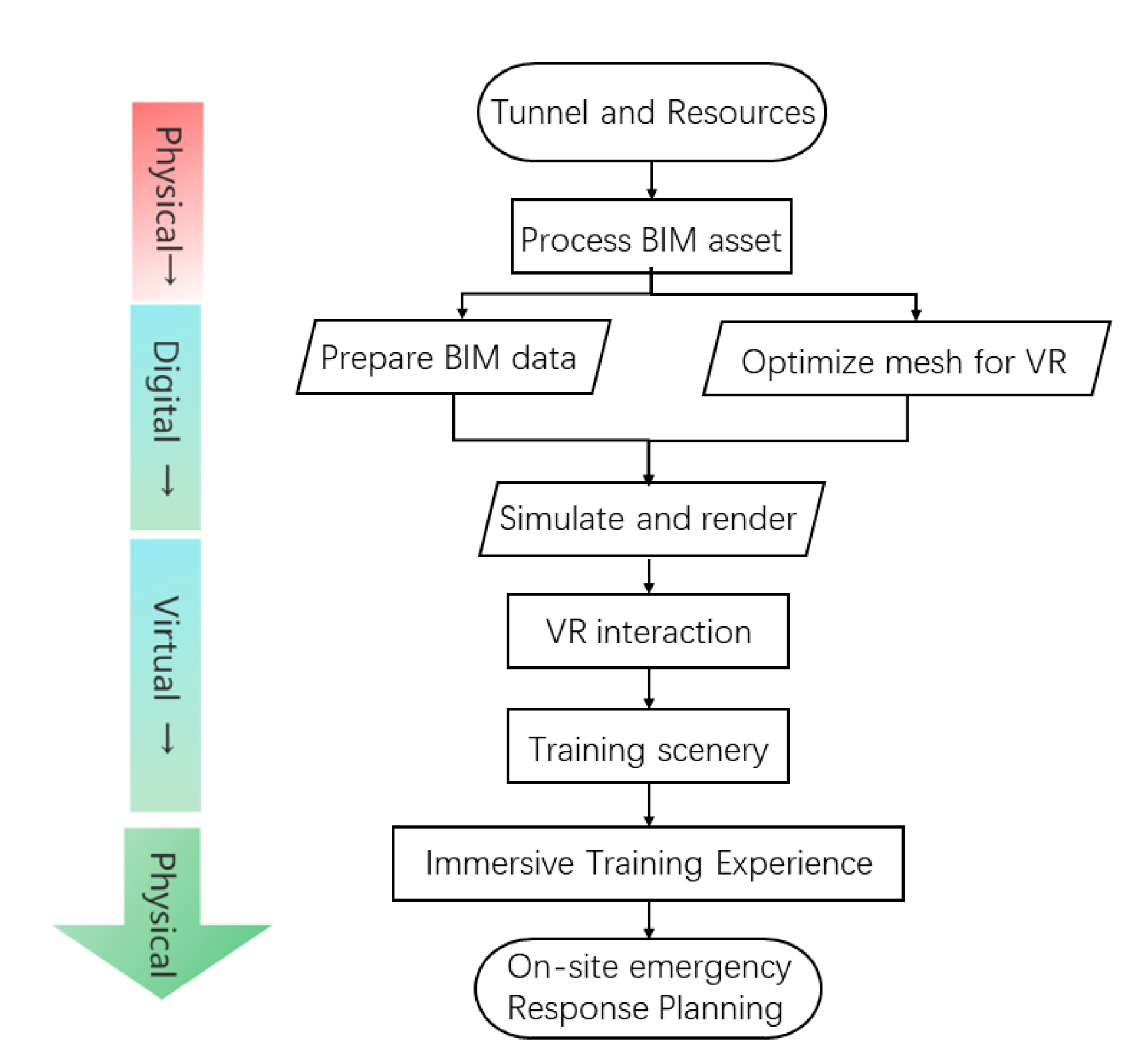
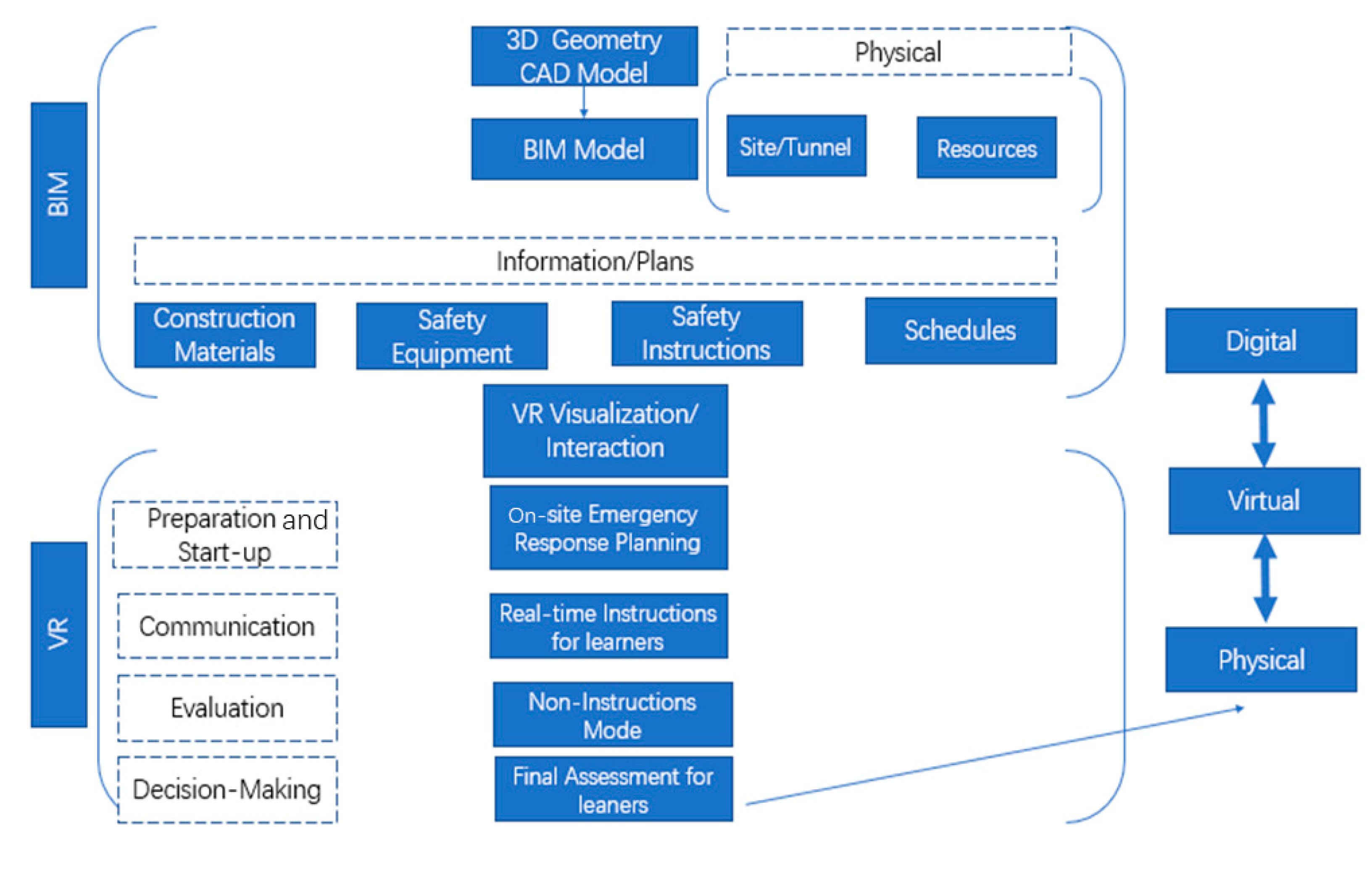

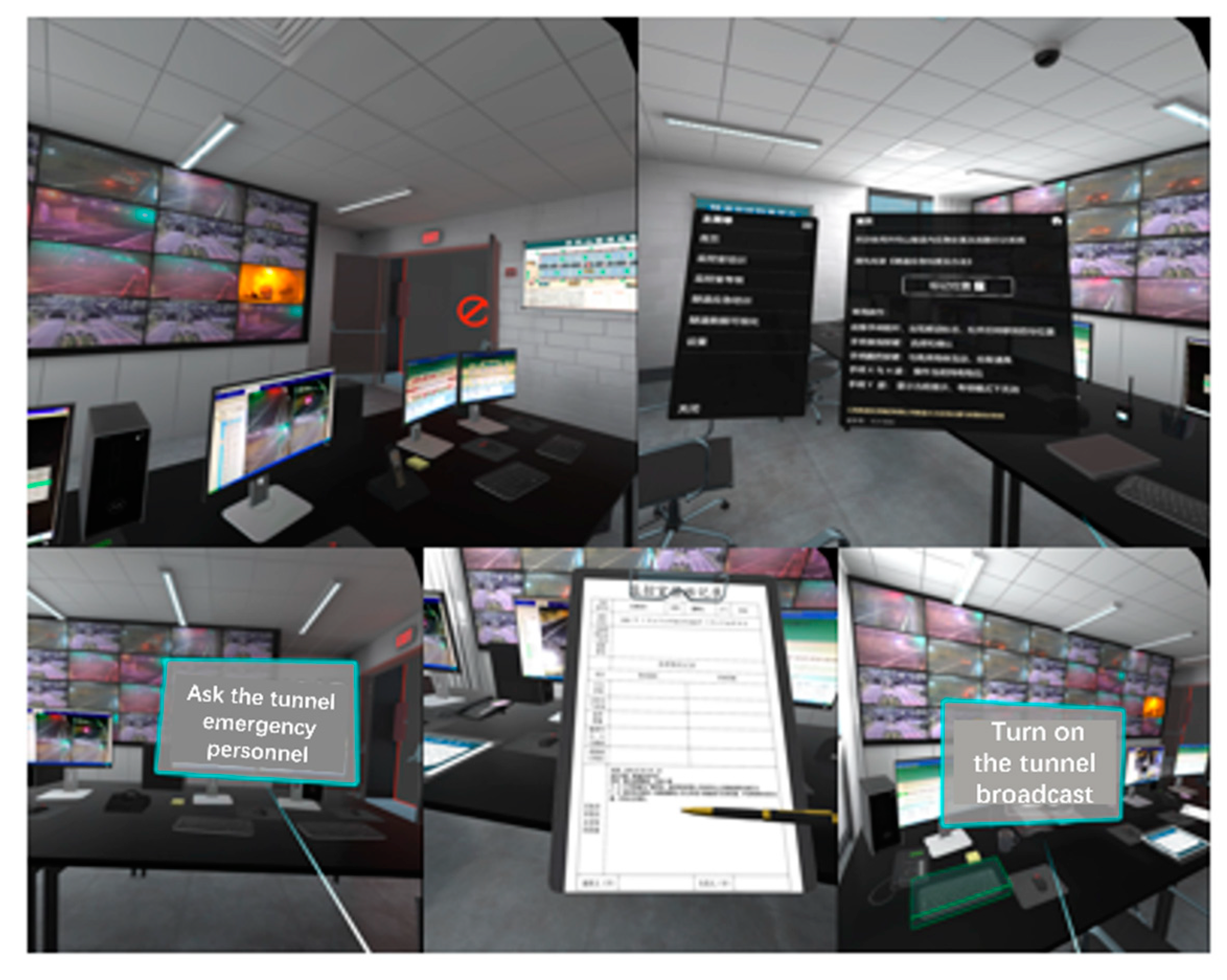

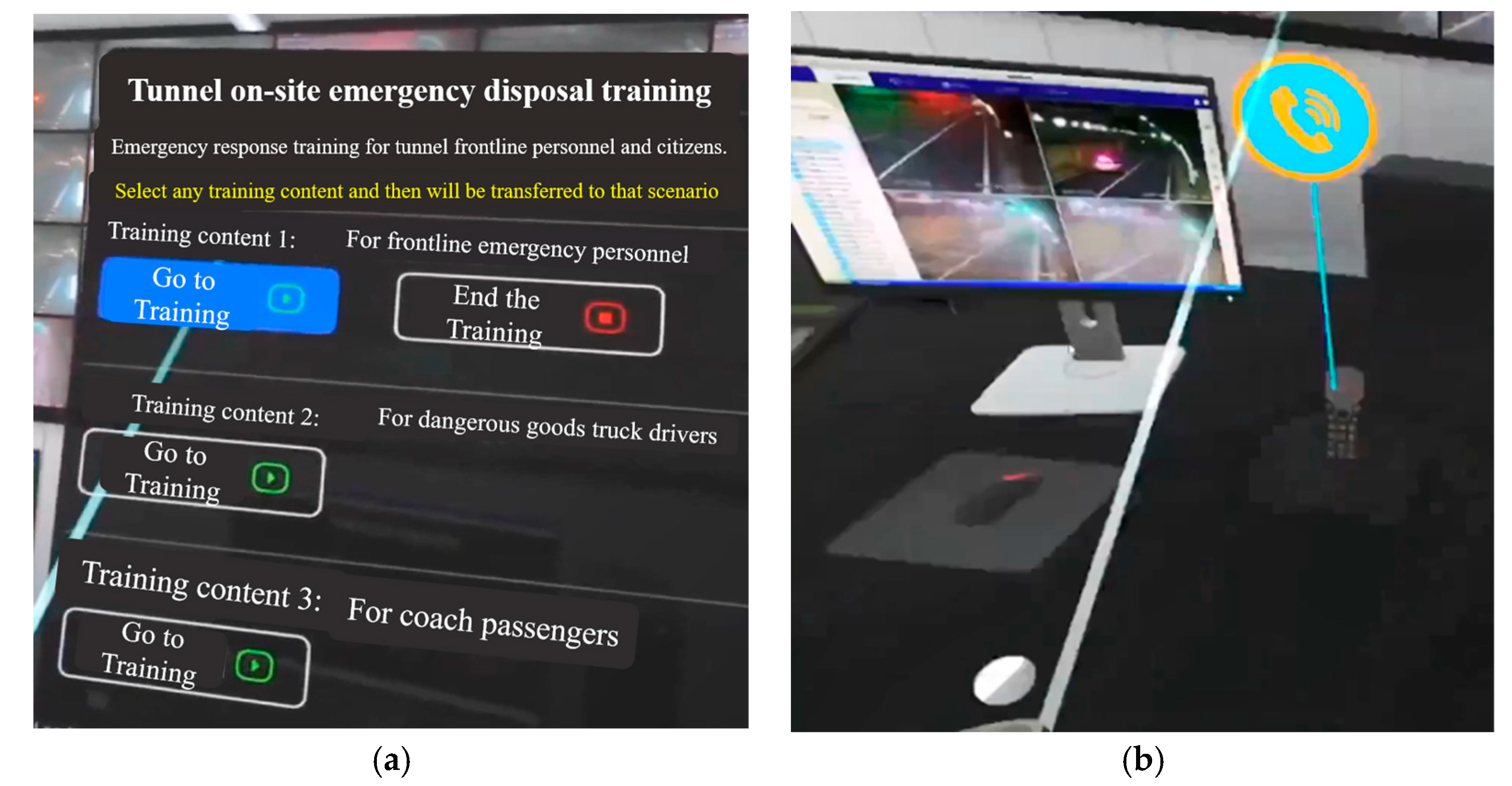

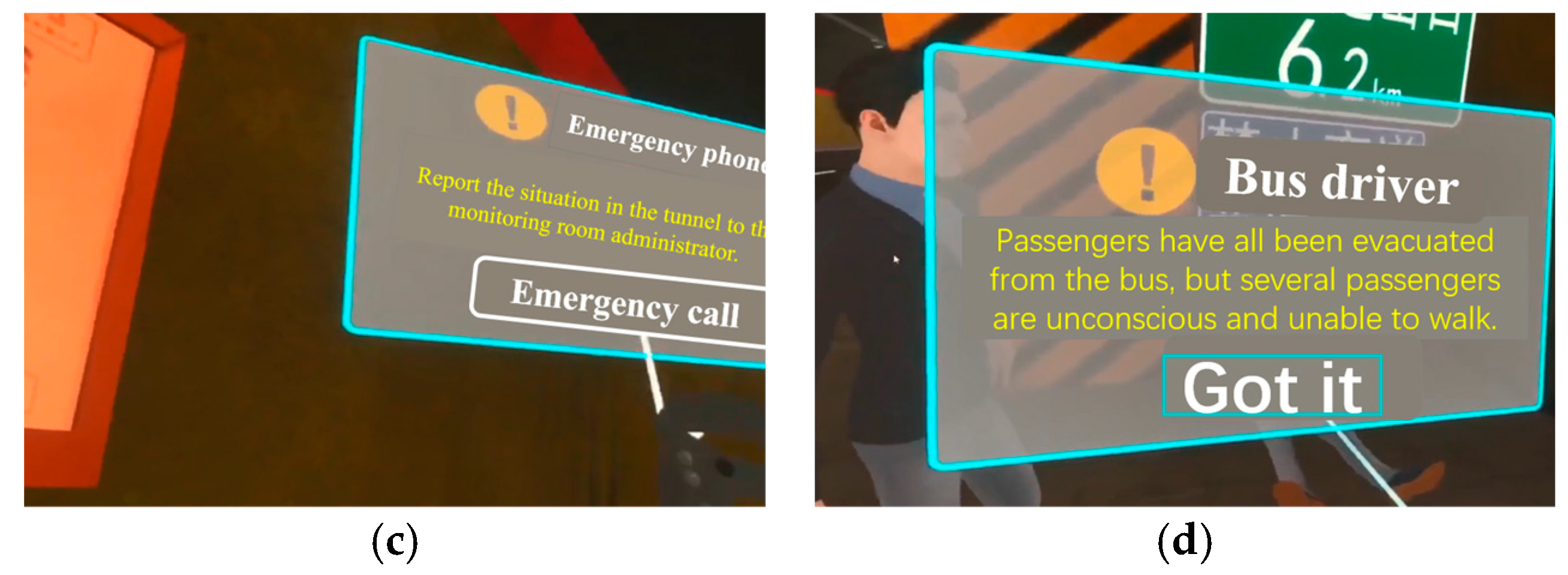
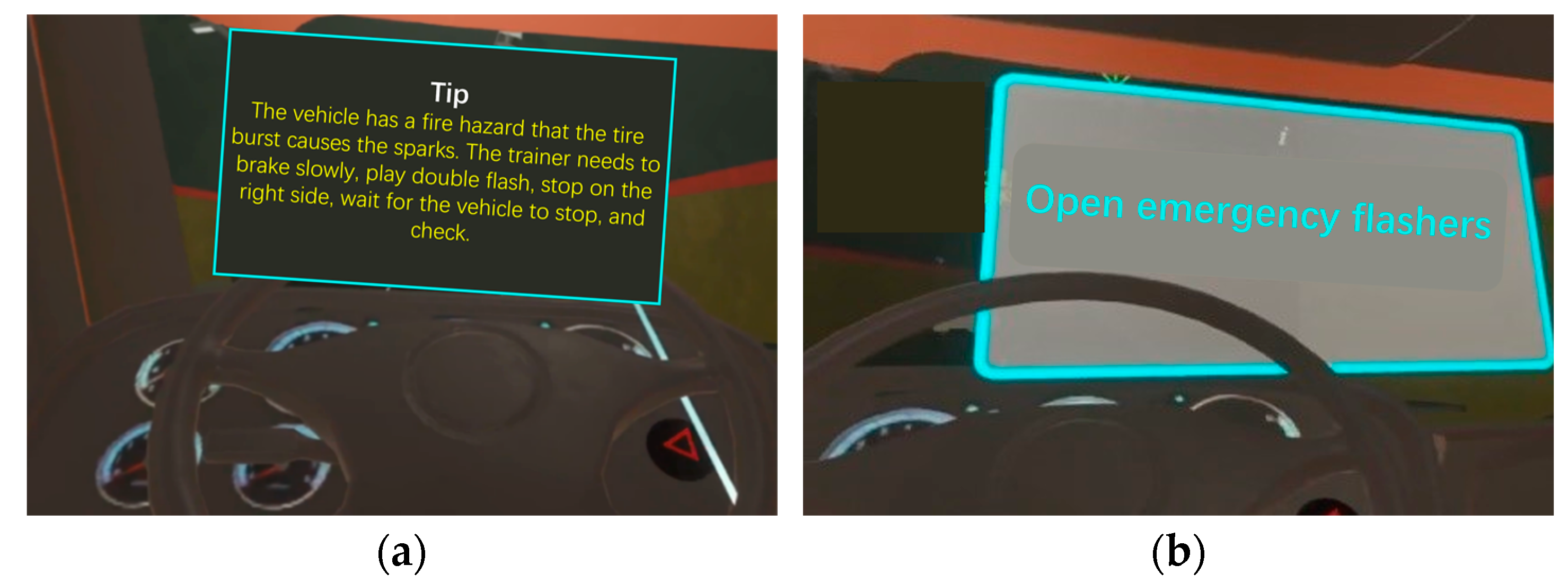
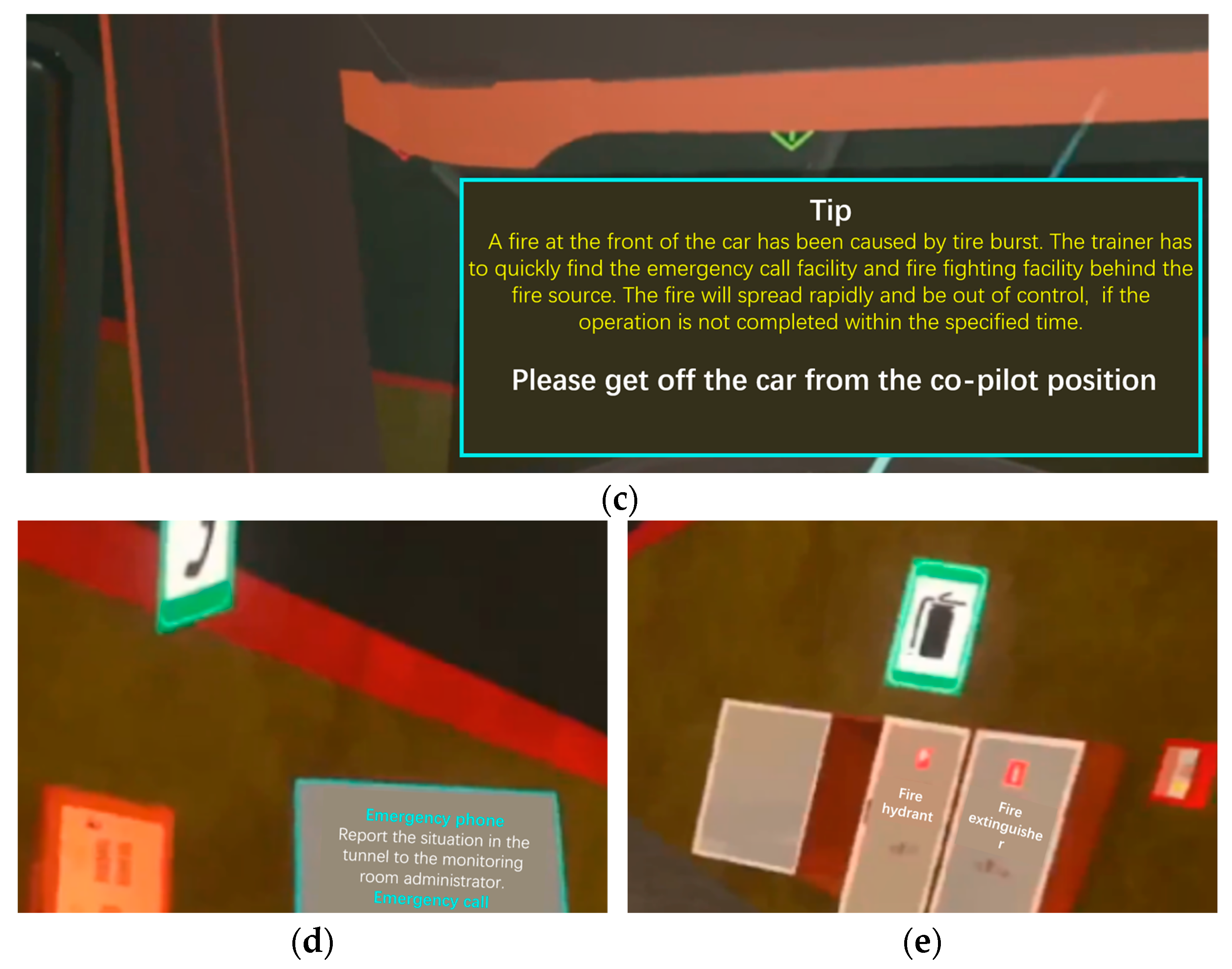
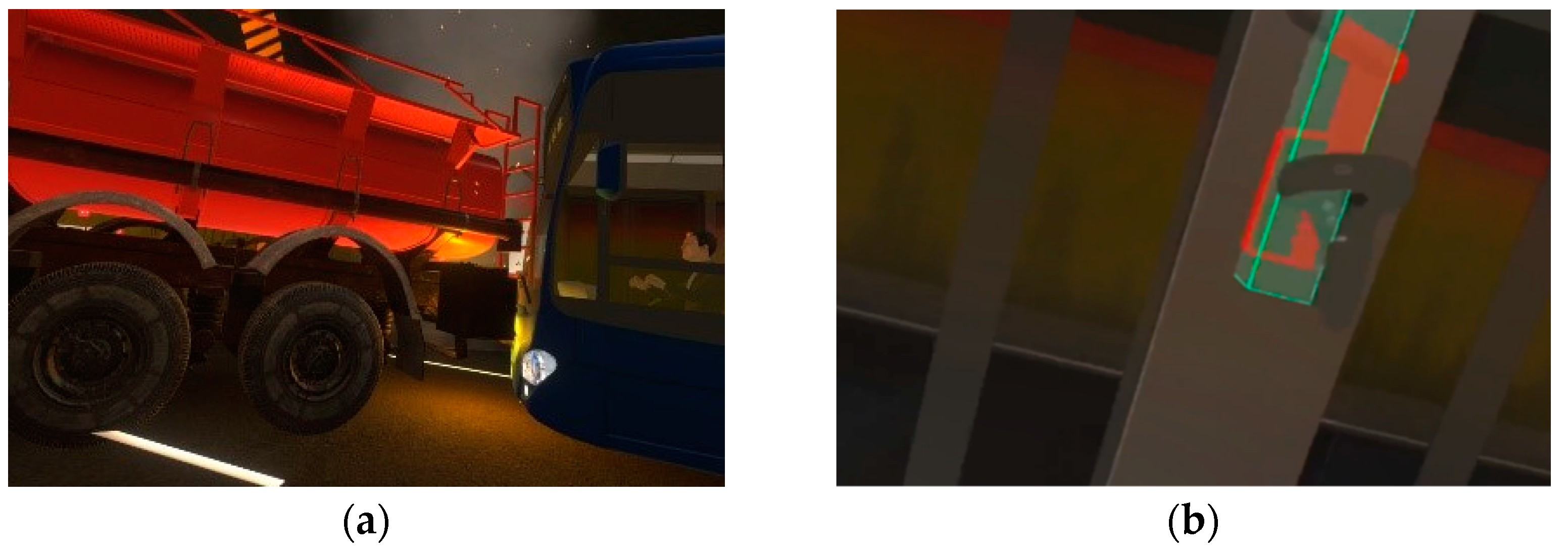
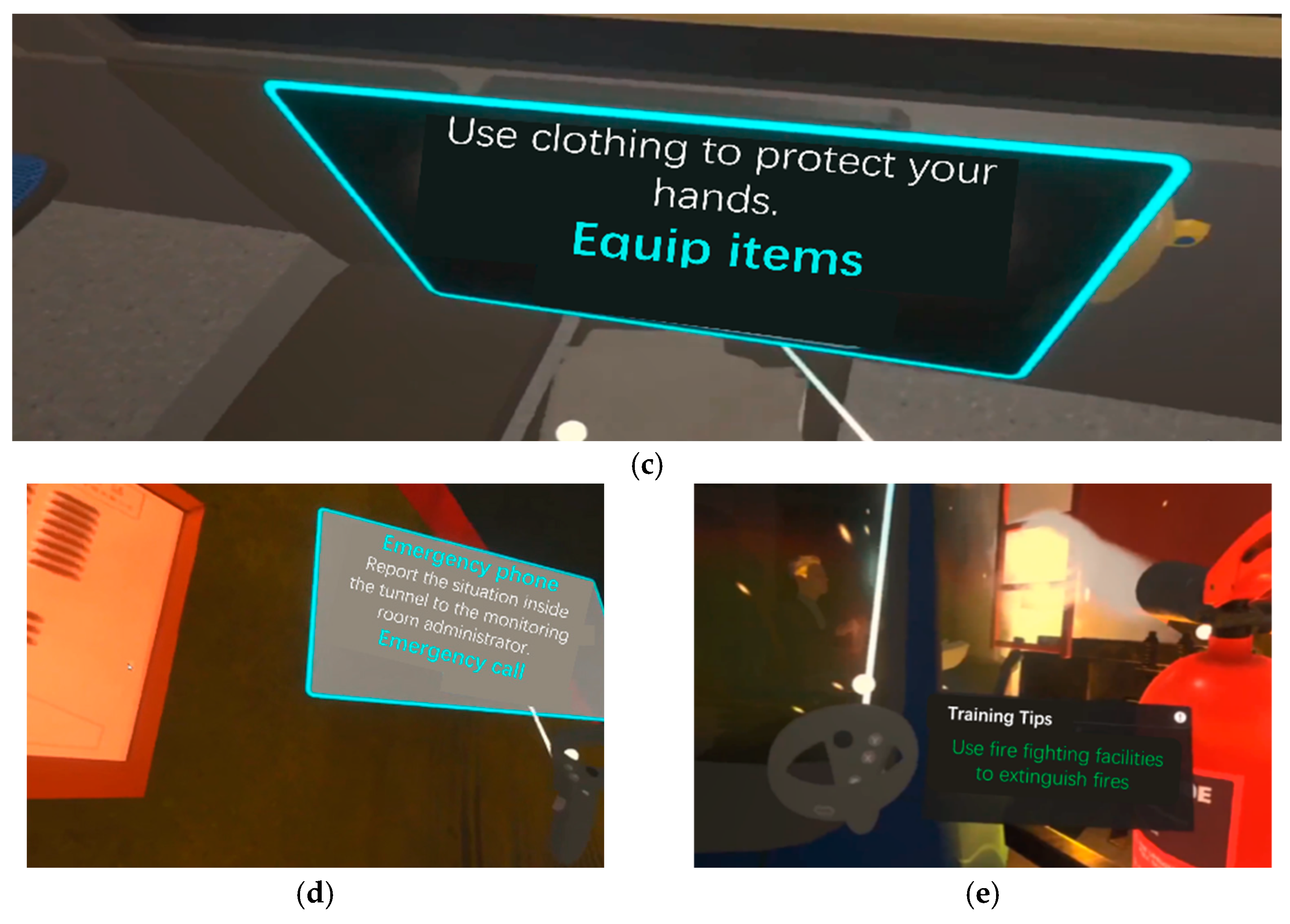
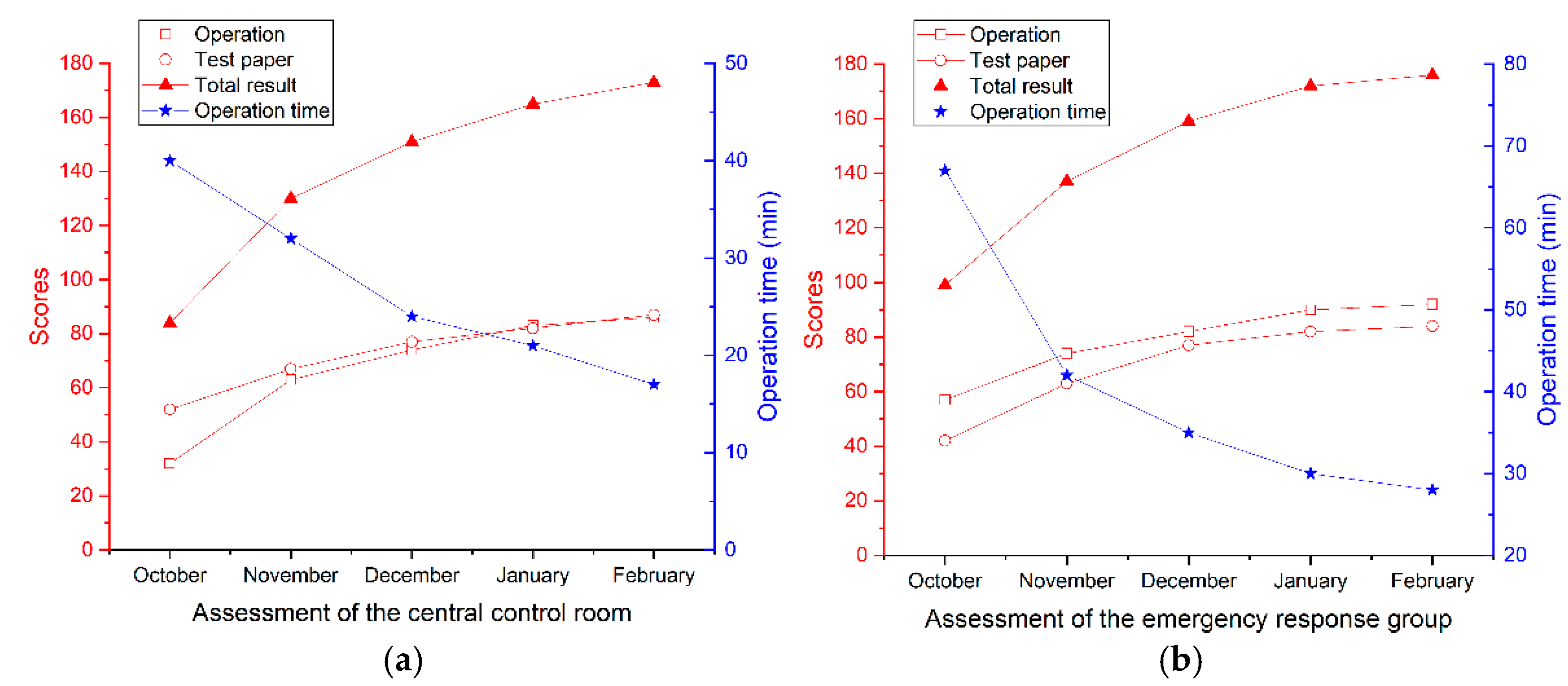
Publisher’s Note: MDPI stays neutral with regard to jurisdictional claims in published maps and institutional affiliations. |
© 2022 by the authors. Licensee MDPI, Basel, Switzerland. This article is an open access article distributed under the terms and conditions of the Creative Commons Attribution (CC BY) license (https://creativecommons.org/licenses/by/4.0/).
Share and Cite
Yu, X.; Yu, P.; Wan, C.; Wang, D.; Shi, W.; Shou, W.; Wang, J.; Wang, X. Integrating Virtual Reality and Building Information Modeling for Improving Highway Tunnel Emergency Response Training. Buildings 2022, 12, 1523. https://doi.org/10.3390/buildings12101523
Yu X, Yu P, Wan C, Wang D, Shi W, Shou W, Wang J, Wang X. Integrating Virtual Reality and Building Information Modeling for Improving Highway Tunnel Emergency Response Training. Buildings. 2022; 12(10):1523. https://doi.org/10.3390/buildings12101523
Chicago/Turabian StyleYu, Xinhua, Pengfei Yu, Chao Wan, Di Wang, Weixiang Shi, Wenchi Shou, Jun Wang, and Xiangyu Wang. 2022. "Integrating Virtual Reality and Building Information Modeling for Improving Highway Tunnel Emergency Response Training" Buildings 12, no. 10: 1523. https://doi.org/10.3390/buildings12101523
APA StyleYu, X., Yu, P., Wan, C., Wang, D., Shi, W., Shou, W., Wang, J., & Wang, X. (2022). Integrating Virtual Reality and Building Information Modeling for Improving Highway Tunnel Emergency Response Training. Buildings, 12(10), 1523. https://doi.org/10.3390/buildings12101523






